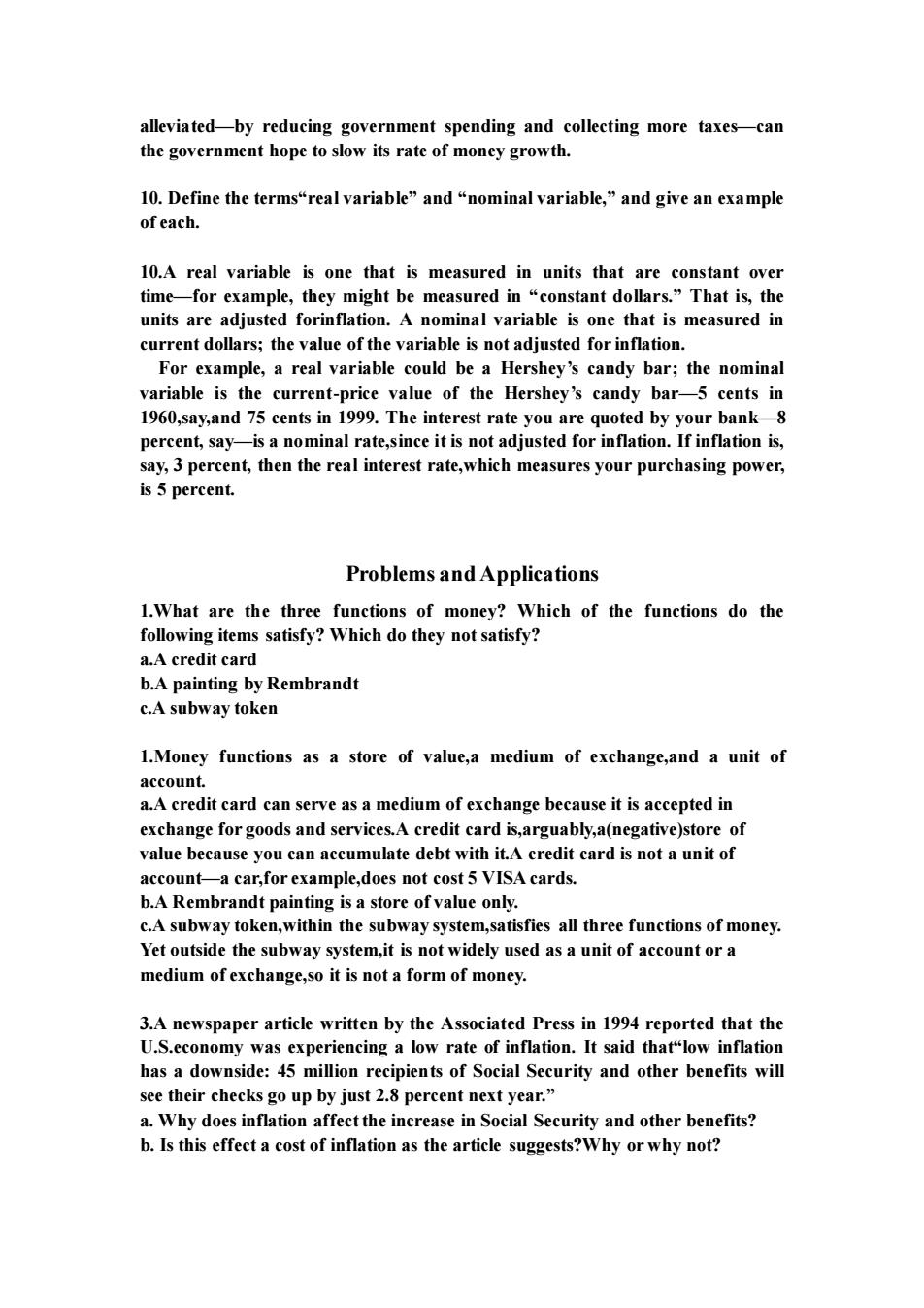正在加载图片...

alleviatedby reducing government spending and collecting more taxescan the government hope to slow its rate of money growth. l0.Define the terms"“real variable”and“nominal variable,.”and give an example ofeach. 10.A real variable is one that is measured in units that are constant over -for example,they might be measured in "constant dollars."That is,the units are adjusted forinflation.A nominal variable is one that is measured in current dollars;the value of the variable is not adjusted for inflation. For example,a real variable could be a Hershey's candy bar:the nominal variable is the current-price value of the Hershey's candy bar -5 cents in 1960,say,and 75 cents in 1999.The interest rate you are quoted I by your bank percent,say-is a nominal rate,since it is not adjusted for inflation.If inflation is, say,3 percent,then the real interest rate,which measures your purchasing power, is 5 percent. Problems and Applications 1.What are the three functions of money?Which of the functions do the following items satisfy?Which do they not satisfy? c.A subway token 1.Money functions as a store of value,a medium of exchange,and a unit of a.A credit card can serve as a medium of exchange because it is accep exchange for goods and services.A credit card is,arguably,a(negative)store of value because you can accumulate debt with it.A credit card is not a unit of account-a car for example,does not cost 5 VISA cards. b.A Rembrandt painting is a store of value only. c.A subway tok ithi a the atisfies all three functions of money. Yet outside the subway system,it is not widely used as a unit of account ora medium of exchange.so it is not a form of monev. 3.A newspaper article written by the Associated Press in 1994r US riencing a low illion recipients of Social Security and other benefits see their checks go up by just 2.8 percent next year." a.Why does inflation affect the increase in Social Security and other benefits? b.Is this effect a cost of inflation as the article suggests?Why or why not?alleviated—by reducing government spending and collecting more taxes—can the government hope to slow its rate of money growth. 10. Define the terms“real variable” and “nominal variable,” and give an example of each. 10.A real variable is one that is measured in units that are constant over time—for example, they might be measured in “constant dollars.” That is, the units are adjusted forinflation. A nominal variable is one that is measured in current dollars; the value of the variable is not adjusted for inflation. For example, a real variable could be a Hershey’s candy bar; the nominal variable is the current-price value of the Hershey’s candy bar—5 cents in 1960,say,and 75 cents in 1999. The interest rate you are quoted by your bank—8 percent, say—is a nominal rate,since it is not adjusted for inflation. If inflation is, say, 3 percent, then the real interest rate,which measures your purchasing power, is 5 percent. Problems and Applications 1.What are the three functions of money? Which of the functions do the following items satisfy? Which do they not satisfy? a.A credit card b.A painting by Rembrandt c.A subway token 1.Money functions as a store of value,a medium of exchange,and a unit of account. a.A credit card can serve as a medium of exchange because it is accepted in exchange for goods and services.A credit card is,arguably,a(negative)store of value because you can accumulate debt with it.A credit card is not a unit of account—a car,for example,does not cost 5 VISA cards. b.A Rembrandt painting is a store of value only. c.A subway token,within the subway system,satisfies all three functions of money. Yet outside the subway system,it is not widely used as a unit of account or a medium of exchange,so it is not a form of money. 3.A newspaper article written by the Associated Press in 1994 reported that the U.S.economy was experiencing a low rate of inflation. It said that“low inflation has a downside: 45 million recipients of Social Security and other benefits will see their checks go up by just 2.8 percent next year.” a. Why does inflation affect the increase in Social Security and other benefits? b. Is this effect a cost of inflation as the article suggests?Why or why not?